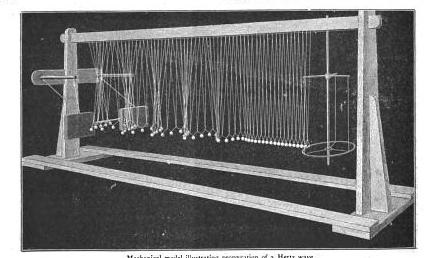JF Ptak Science Books Quick Post
This fine, geometrical wooden apparatus was made by electrician and physicist Sylvanus P. Thompson (1851-1911)--two metres long, the model was for a demonstration before the Physical Society of London, "illustrat(ing) the propagation of a transverse wave". The image appeared in Nature, August 12, 1897.
"At one end is the oscillator a heavy mass of brass hung by two strong cords from arms which project parallel to the longer dimension of the frame. This mass which for the sake of analogy is quite unnecessarily shaped to imitate an orthodox electric oscillator can therefore be set swinging in a transverse direction by a suitable impulse given by hand. At the other end of the frame is the "resonator" a circle of brass wire hung by a tri filar suspension Oscillator and resonator must be adjusted by shortening or lengthening the cords so as to have identical periods of oscillation. The real problem in the construction of the apparatus was to find a mechanical means of transmitting the the energy of the oscillator in visible waves to the resonator. The means finally adopted was a series of inter connected pendulums on a plan somewhat similar to one suggested in 1877 by Prof Osborne Reynolds. Instead of using springs however the requisite inter connection is obtained by simply suspending the leaden bullets which act as pendulum bobs by V suspensions ,which overlap and which as shown in the cut are tied together at a point about 4 centimetres above each of the balls. No ball can be laterally displaced without tending to drag its neighbour also so that a shearing stress is transmitted along the line of balls As Reynolds showed twenty years ago the velocity of propagation of the wave front differs from that of the group of waves owing to the continual dying away of the amplitude of the advancing waves. This effect due to the inertia of the medium is of course equivalent to the presence of dispersion in the medium waves of different frequencies being propagated with slightly different velocities. So far, therefore, as I Prof Fitzgerald remarked when the model was exhibited it illustrates the propagation of the wave in a refracting medium rather than in the ether of space. The waves in the model travel quite slowly and there is a fascination in watching their progress along the row of balls until they arrive at the resonator and set it into responsive vibration. There is of course no attempt made here to represent the magnetic part of the electromagnetic wave at right angles to the electrostatic part the mechanical displacements in the model corresponding to the electrostatic displacements of the Hertzian wave. A row of interconnected pendulums such as this affords a means of illustrating many points in physics For many purposes the elaborate system of suspension by strings may be replaced by a continuous fabric. Thus for example a piece of netting hung on hooks from a horizontal rail and ending below in a short fringe with leaden beads on the fringe tips will also serve to illustrate the propagation of a transverse wave. The structure adopted absolutely refuses to transmit longitudinal disturbances there being no compressional elasticity between the balls to propagate a longitudinal wave."



Comments